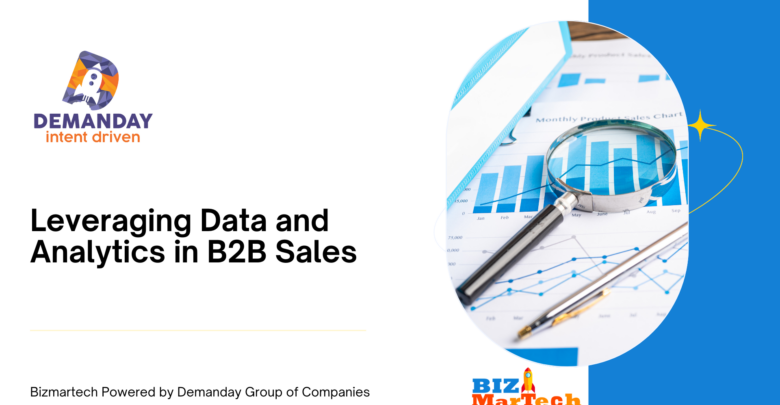Sales
Leveraging Data and Analytics in B2B Sales

In today’s competitive B2B (business-to-business) environment, the traditional sales strategies of cold calls and generic email campaigns are no longer enough to secure long-term success. To thrive in an increasingly data-driven world, B2B companies are turning to data and analytics to transform their sales operations, optimize strategies, and ultimately drive revenue growth.
Data and analytics in B2B sales not only provide insights into customer behavior but also empower sales teams to make informed, real-time decisions that increase efficiency and conversion rates. This article explores how leveraging data and analytics can redefine B2B sales processes, improve customer engagement, and foster business growth.
1. The Importance of Data in B2B Sales
In B2B sales, customer relationships are key. A deep understanding of your customers’ needs, behaviors, and preferences can be the differentiator between winning or losing a deal. Data-driven insights can unlock new opportunities and uncover patterns that would otherwise remain hidden. Sales teams who integrate data into their daily operations can better predict customer needs, personalize interactions, and build more meaningful relationships.
Some critical types of data that can drive B2B sales effectiveness include:
- Customer Data: Information about company size, industry, geographic location, buying history, and decision-making processes.
- Behavioral Data: Insights derived from tracking how prospects and existing customers engage with your website, content, and emails.
- Sales Activity Data: Metrics related to sales calls, emails, meetings, and conversion rates.
- Market Data: Information on industry trends, competitor activities, and external factors that could influence customer decisions.
2. Enhanced Lead Generation and Prospecting
The first step in the B2B sales cycle is lead generation, and data can significantly enhance this process. By using advanced analytics and AI-driven tools, sales teams can identify high-potential leads who are more likely to convert into customers.
Key Ways Data Drives Lead Generation:
- Predictive Analytics: By analyzing historical data and patterns, predictive models can forecast which leads are most likely to close. This allows sales teams to focus their efforts on high-quality leads.
- Lead Scoring: Combining demographic data (e.g., company size, industry) with behavioral data (e.g., website visits, content downloads) enables businesses to assign lead scores, ensuring that sales teams prioritize the most promising prospects.
- Account-Based Marketing (ABM): ABM strategies rely heavily on data to identify and target key accounts that fit your ideal customer profile. Data analytics helps pinpoint the right companies, the right decision-makers, and the most effective messaging.
3. Personalizing Sales Outreach
Gone are the days of one-size-fits-all sales pitches. Modern B2B buyers expect a personalized experience, and data is the key to providing it. By leveraging customer insights, sales teams can tailor their communications, offers, and follow-up strategies to meet the unique needs of each prospect or customer.
How Data Enhances Personalization:
- Customer Segmentation: Data can help divide your customer base into distinct segments based on factors such as industry, pain points, purchasing behavior, and budget. This allows sales teams to customize their approach for each segment.
- Behavioral Triggers: Data tracking tools allow sales teams to monitor when a lead engages with specific content (e.g., downloading a white paper or attending a webinar). This behavioral data can trigger timely follow-ups or content offers tailored to the lead’s interests.
- Customer Journey Mapping: By analyzing the buyer’s journey, sales teams can better understand where the prospect is in the decision-making process, allowing for more relevant and effective touchpoints at each stage.
4. Optimizing Sales Performance
Data analytics is a powerful tool for optimizing the performance of your sales team. By analyzing sales data in real time, sales managers can identify which strategies are working and which are not, enabling them to make data-backed decisions that drive better results.
Key Metrics to Track for Sales Optimization:
- Conversion Rates: Analyze how many leads progress to each stage of the sales funnel and identify bottlenecks or areas where prospects drop off.
- Sales Cycle Length: Measure how long it takes to close deals and identify ways to speed up the process without sacrificing quality.
- Sales Activity: Track the number of calls, meetings, and emails each salesperson is making. Use this data to set performance benchmarks and ensure consistent activity.
- Sales Quotas and Goals: Using data, sales managers can set realistic and achievable goals for each team member based on historical performance and market conditions.
5. Data-Driven Sales Forecasting
Accurate forecasting is critical to any sales strategy. With the right data, sales teams can better predict revenue, allocate resources more efficiently, and adjust strategies proactively.
The Role of Data in Forecasting:
- Historical Data: By analyzing past sales trends, organizations can predict future performance with greater accuracy. Trends such as seasonality, changes in buyer behavior, or economic shifts can all influence sales forecasts.
- Lead Data: Combining predictive analytics and lead scoring data, businesses can forecast the likelihood of closing deals with a higher degree of certainty.
- Opportunity Stage Data: Data on where each opportunity stands in the sales funnel (e.g., initial contact, proposal stage, negotiation) can be used to more accurately forecast revenue.
6. Improving Customer Retention and Upselling
In B2B sales, the relationship doesn’t end with the sale. Retaining customers and maximizing customer lifetime value (CLV) is just as important as acquiring new ones. Data and analytics are crucial to identifying opportunities for upselling, cross-selling, and improving customer satisfaction.
Data-Driven Approaches for Retention:
- Customer Health Scoring: By analyzing usage patterns, engagement, and feedback, companies can create customer health scores that predict potential churn or identify accounts that are at risk.
- Usage Data: Sales teams can analyze how customers are using their products or services and recommend additional features or products that add value.
- Customer Feedback: Surveys, reviews, and direct customer feedback provide insights into areas for improvement and opportunities to upsell complementary products or services.
7. Integrating Data Across Teams
Data-driven sales strategies require collaboration across departments. The marketing, sales, and customer success teams must work together to ensure that data is effectively shared and leveraged.
Steps to Integrate Data Across Teams:
- CRM Systems: Centralized customer relationship management (CRM) platforms allow data to flow seamlessly between marketing, sales, and support teams.
- Collaboration Tools: Sharing insights from data analytics platforms in real-time can foster alignment and improve communication across teams.
- Cross-Functional Metrics: Sales, marketing, and customer success teams should track shared metrics (e.g., customer lifetime value, conversion rates) to ensure everyone is working toward common goals.
Conclusion: The Future of B2B Sales Is Data-Driven
As B2B sales continue to evolve, data and analytics are becoming an indispensable part of the process. From lead generation and personalization to sales forecasting and customer retention, data-driven decision-making enables businesses to optimize every aspect of their sales operations.




